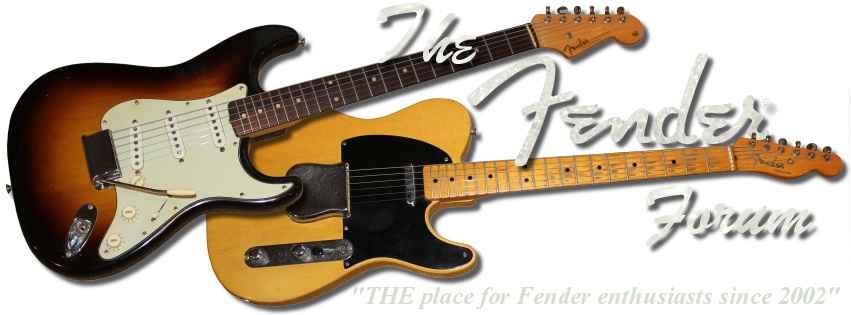-
Forum Member

My SFDR crack!!
I've been very fustrated these days cos my '72 DR gives out a noisy cracking sound when I just only play for 10 mins. Even if I turn of the volume momentarily the cracking noise doesn't go off, only until I turn of the power. What is the problem? Do I need to change anything?
Thanks for all the help!
cheers!
-
Moderator
TFF Stage Crew

Fuel,
You stated that the amp still crackles with the volume turned down. If that is the case then I doubt it is a tube.
Most likely you need to change all the 100k ohm 1/2 watt plate load resistors. This is very cheap to do if you can do it yourself. The resistors won't be more than $6.00 or so.
Carbon composition plate load resistors get hot and over time drift and become noisy. This is a VERY common problem with older Fender amps.
Good Luck,
Tim C. :)
-
Forum Member

Thanks Tim!
How many are there in total? I'm totally a nut about resistors.
How to go about doing it? What do they look like? I need a solder right?
-
Moderator
TFF Stage Crew

There are six 100k 1/2 watt resistors that you need to replace.
The easiest way to tell you which ones to replace would be to highlight them on a layout drawing and send it to you.
The problem is, if you have never worked on an amp there are some potentially lethel voltages to deal with. You must be very careful doing this. It might be more difficult than you want to tackle if you have never soldered before.
Let me know if you feel you can do it yourself.
Tim C. :)
-
Forum Member

Hey Tim!
Thanks for the concern! I would like to try to do it myself.
Let me know the precautions and how to do it!
Thanks again!
-
Moderator
TFF Stage Crew

First buy six 100k 1/2 watt resistors. Metal film are much quieter than carbon composition resistors.
You will need a 25 to 35 watt soldering iron and a roll of 60/40 rosin core solder for electrical work. All cheap items at Radio Shack. A set of needle nose pliers will also be helpful.
MAKE SURE THE AMP IS UNPLUGGED AND HAS NOT BEEN PLAYED FOR A DAY BEFORE ATTEMPTING THIS. YOUR AMP HAS ABOUT 450 VOLTS GOING TO THE PLATES OF THE OUTPUT TUBES. THERE ARE FILTER CAPS THAT STORE CURRENT THAT CAN BE DEADLY IF YOU ARE NOT CAREFUL.
To remove the chassis there are 4 bolts going through the top of the cabinet with nuts on the bottom. Loosen the screws and remove the nuts. Pull the bolts out of the cab after removing the nuts.
Remove the screw that hold the power cord in place and remove the reverb cables and speaker cable and slide the chassis out of the cabinet. Place it on your work area with the back facing you and the controls facing away.
Look at the edge of the left side of the circuit board facing you. Locate the resistors that form a V shape on the board. They will have colored bands on them. The colors will be brown, black yellow and probably silver. Dont worry about the fourth color band. That is the resistors tolerance. That is the first pair of resistors to replace.
Look about 2 1/2 inches to the left and you will see another set of resistors also in a V shape. That is the second set to replace.
Look to the left again 2 1/2 inches and that will be the last set of resistors to replace.
Heat the soldering iron fully before beginning.
Place the soldering iron on the solder joint holding the two resistors at the top of the V and only heat it until you can pull the resistors free on that end from the board. Do not overheat the area.
Heat the separate joints for the other end of each resistors and remove them. Replace the resistors in the same manner that they were removed and you are done.
Just remember not poke around inside the amp as there are several hundered volts floating around inside the amp.
Good Luck,
Tim C.
-
Forum Member

DRs generally don't have the circuit that self-discharges the caps, so you should discharge them before you start working on the resistors just in case. The easiest way to do this is right at either terminal of the standby switch with the switch in the play position. If the amp has been off for a day, you can short either terminal to the chasis with an insulated screwdriver(make sure you're holding the insulated part). A nicer way to do it is with a jumper made up of 2 insulated alligater clips, a 1K-10K 2 watt resistor, and a lot of heat shrink insulation! I like to leave it connected(standby to chasis) while working as sometimes caps will reform a small charge. Just make sure to disconnect it when powering up the amp.
Last edited by Teleologist; 09-20-2002 at 09:04 AM.
 Posting Permissions
Posting Permissions
- You may not post new threads
- You may not post replies
- You may not post attachments
- You may not edit your posts
-
Forum Rules




 Reply With Quote
Reply With Quote

